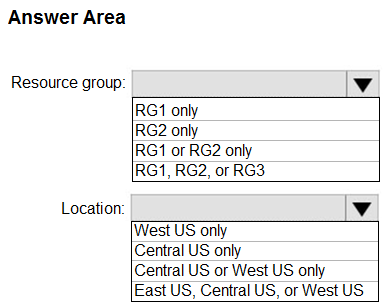

HOTSPOT -
You have an Azure subscription that contains the resources shown in the following table.
VMSS1 is set to VM (virtual machines) orchestration mode.
You need to deploy a new Azure virtual machine named VM1, and then add VM1 to VMSS1.
Which resource group and location should you use to deploy VM1? To answer, select the appropriate options in the answer area.
NOTE: Each correct selection is worth one point.
Hot Area:

mlantonis
Highly Voted 3 years, 11 months agoRVivek
5 months agomaria_saprykina
2 years, 4 months agotirajvid
1 year, 7 months agoRVivek
5 months agohebbo777
1 year, 6 months agoBatiste2023
1 year, 5 months agoSumanSaurabh
2 years, 4 months agofedztedz
Highly Voted 4 years, 3 months agoitgg11
3 years, 2 months agoLazylinux
2 years, 10 months ago8ac3742
Most Recent 4 weeks, 1 day agoRVivek
5 months agoRVivek
5 months ago[Removed]
7 months agopasangawa
7 months, 3 weeks agopet3r
8 months, 1 week agotashakori
1 year, 1 month agogargaditya
1 year, 3 months agogargaditya
1 year, 3 months agogargaditya
1 year, 3 months agoSiraf
1 year, 9 months agoikidreamz
1 year, 8 months agopokrz26
1 year, 10 months agoRandomNickname
1 year, 10 months agoxRiot007
1 year, 10 months agomanthlan
2 years, 5 months agoLiriano
2 years, 5 months agoqwerty100
2 years, 6 months agoEmnCours
2 years, 7 months ago